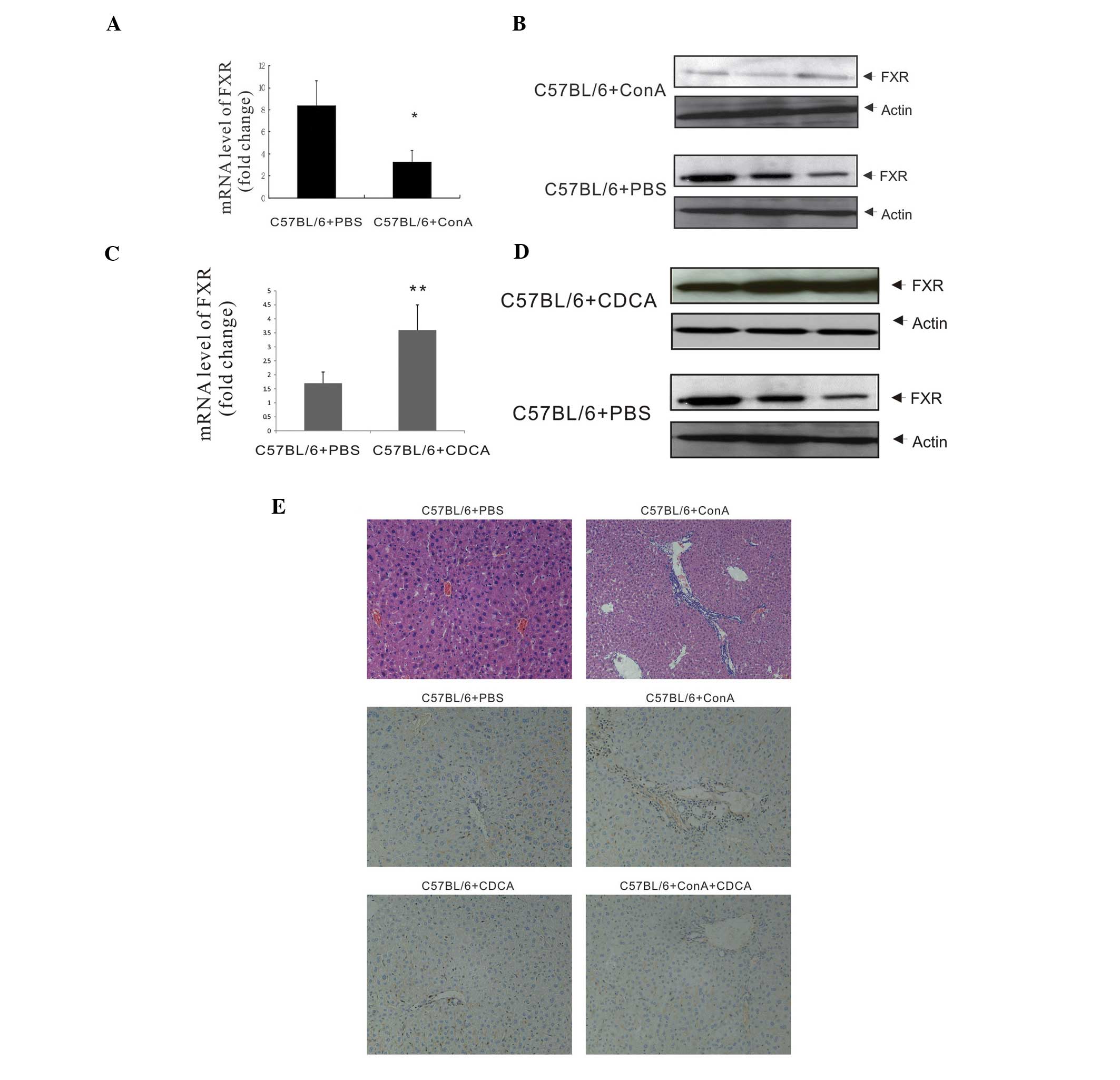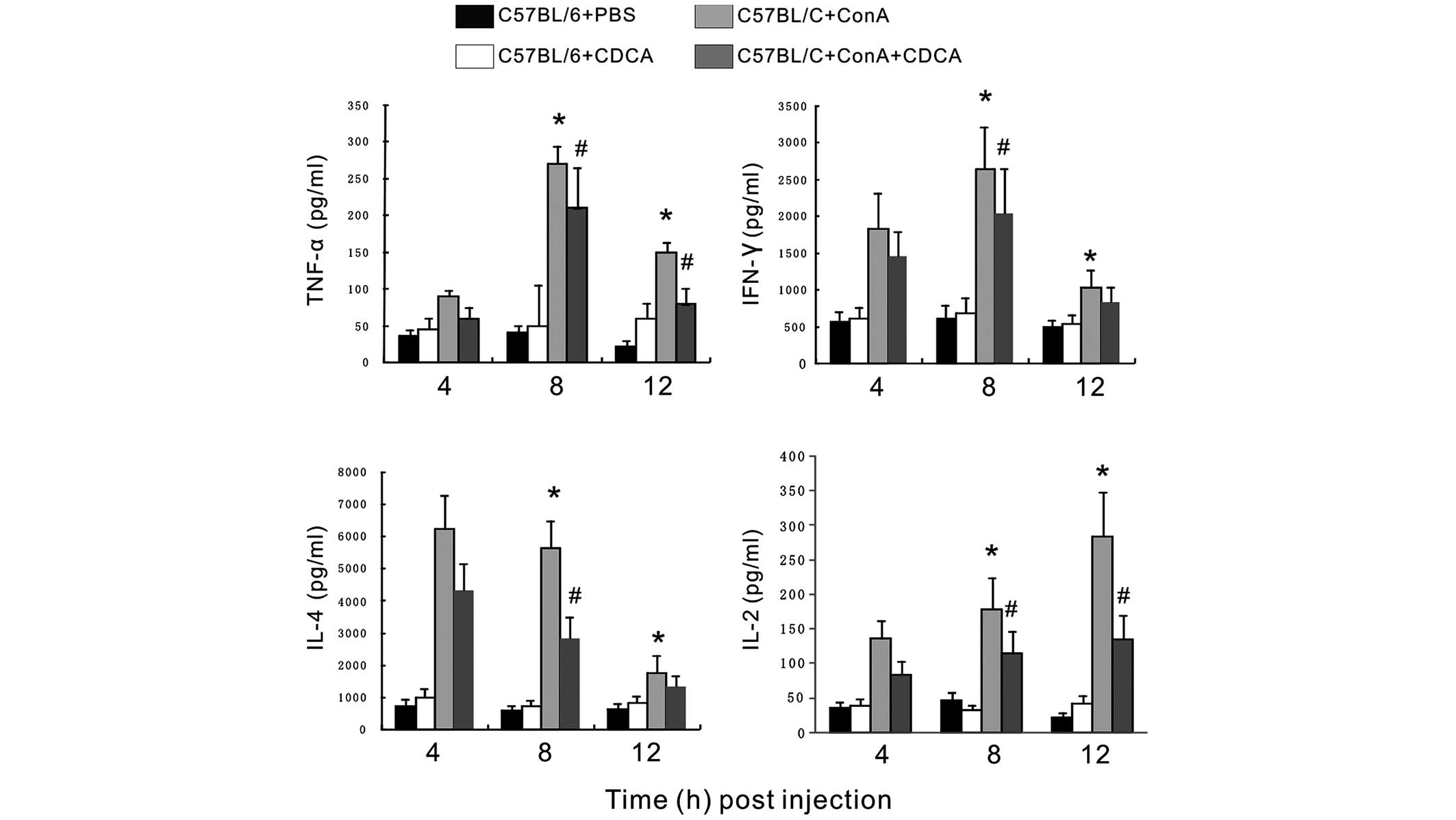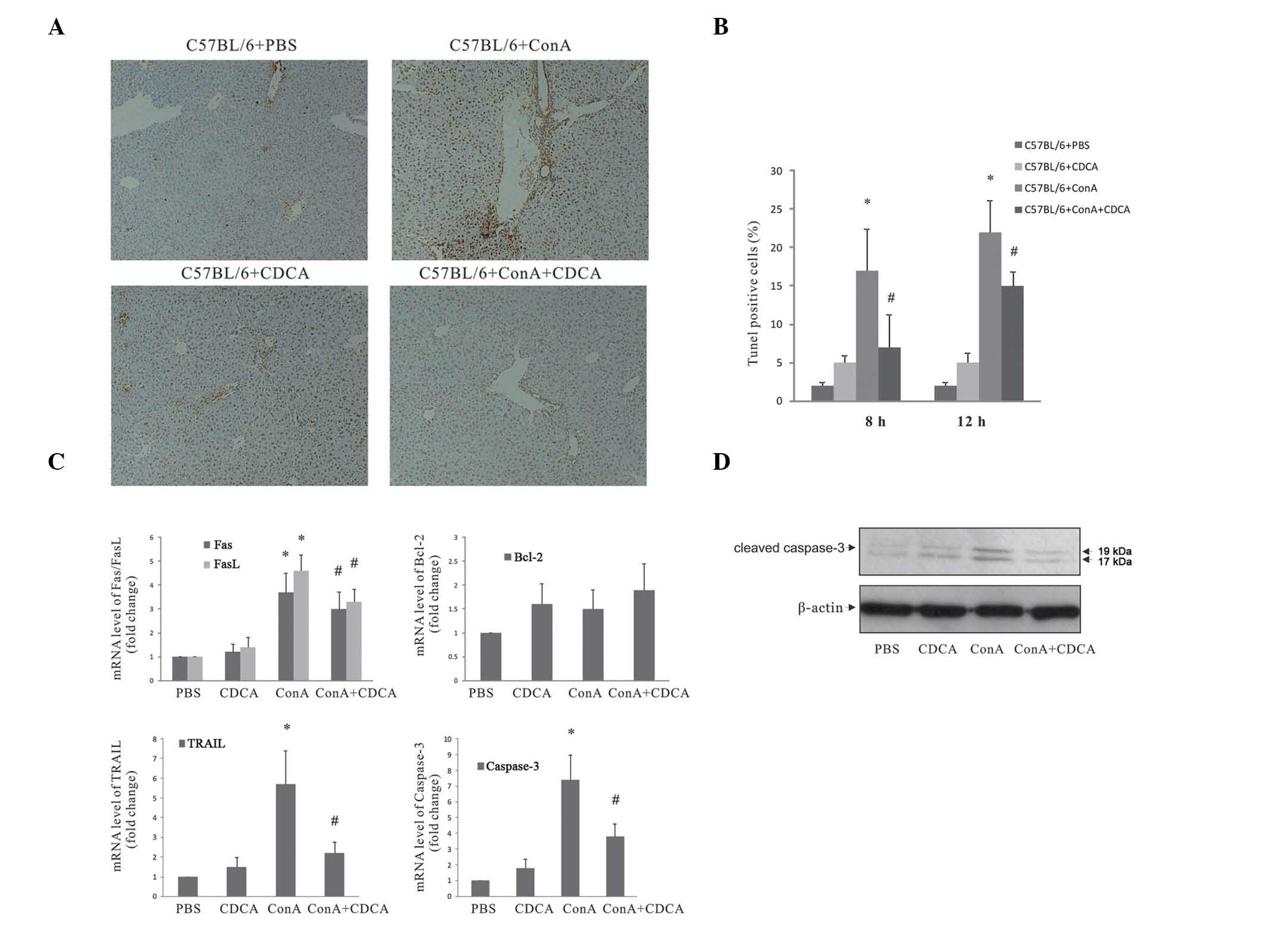|
1
|
Vergani D and Mieli-Vergani G:
Aetiopathogenesis of autoimmune hepatitis. World J Gastroenterol.
14:3306–3312. 2008. View Article : Google Scholar : PubMed/NCBI
|
|
2
|
Lapierre P, Béland K, Yang R and Alvarez
F: Adoptive transfer of ex vivo expanded regulatory T cells in an
autoimmune hepatitis murine model restores peripheral tolerance.
Hepatology. 57:217–227. 2013. View Article : Google Scholar
|
|
3
|
Strassburg CP: Autoimmune hepatitis. Dig
Dis. 31:155–163. 2013. View Article : Google Scholar : PubMed/NCBI
|
|
4
|
Sebode M and Lohse AW: Future perspective:
Immunomodulatory therapy for autoimmune hepatitis. Dig Dis.
32:502–506. 2014. View Article : Google Scholar : PubMed/NCBI
|
|
5
|
Trivedi PJ and Hirschfield GM: Treatment
of autoimmune liver disease: Current and future therapeutic
options. Ther Adv Chronic Dis. 4:119–141. 2013. View Article : Google Scholar : PubMed/NCBI
|
|
6
|
Manns MP, Czaja AJ, Gorham JD, Krawitt EL,
Mieli-Vergani G, Vergani D and Vierling JM: American Association
for the Study of Liver Diseases: Diagnosis and management of
autoimmune hepatitis. Hepatology. 51:2193–2213. 2010. View Article : Google Scholar : PubMed/NCBI
|
|
7
|
Wang YD, Chen WD, Moore DD and Huang W:
FXR: A metabolic regulator and cell protector. Cell Res.
18:1087–1095. 2008. View Article : Google Scholar : PubMed/NCBI
|
|
8
|
Lee FY, Lee H, Hubbert ML, Edwards PA and
Zhang Y: FXR, a multipurpose nuclear receptor. Trends Biochem Sci.
31:572–580. 2006. View Article : Google Scholar : PubMed/NCBI
|
|
9
|
Fiorucci S, Rizzo G, Donini A, Distrutti E
and Santucci L: Targeting farnesoid X receptor for liver and
metabolic disorders. Trends Mol Med. 13:298–309. 2007. View Article : Google Scholar : PubMed/NCBI
|
|
10
|
Renga B, Mencarelli A, Cipriani S, D'Amore
C, Carino A, Bruno A, Francisci D, Zampella A, Distrutti E and
Fiorucci S: The bile acid sensor FXR is required for
immune-regulatory activities of TLR-9 in intestinal inflammation.
PloS One. 8:e544722013. View Article : Google Scholar : PubMed/NCBI
|
|
11
|
McMahan RH, Wang XX, Cheng LL, Krisko T,
Smith M, El Kasmi K, Pruzanski M, Adorini L, Golden-Mason L, Levi
M, et al: Bile acid receptor activation modulates hepatic monocyte
activity and improves nonalcoholic fatty liver disease. J Biol
Chem. 288:11761–11770. 2013. View Article : Google Scholar : PubMed/NCBI
|
|
12
|
Fiorucci S, Cipriani S, Mencarelli A,
Renga B, Distrutti E and Baldelli F: Counter-regulatory role of
bile acid activated receptors in immunity and inflammation. Curr
Mol Med. 10:579–595. 2010.PubMed/NCBI
|
|
13
|
Vavassori P, Mencarelli A, Renga B,
Distrutti E and Fiorucci S: The bile acid receptor FXR is a
modulator of intestinal innate immunity. Journal of immunology
(Baltimore, Md.: 1950). 183:6251–6261. 2009. View Article : Google Scholar
|
|
14
|
Capello A, Moons LM, Van de Winkel A,
Siersema PD, van Dekken H, Kuipers EJ and Kusters JG: Bile
acid-stimulated expression of the farnesoid X receptor enhances the
immune response in Barrett esophagus. Am J Gastroenterol.
103:1510–1516. 2008. View Article : Google Scholar : PubMed/NCBI
|
|
15
|
Tiegs G, Hentschel J and Wendel A: A T
cell-dependent experimental liver injury in mice inducible by
concanavalin A. J Clin Invest. 90:196–203. 1992. View Article : Google Scholar : PubMed/NCBI
|
|
16
|
Shao X, Qian Y, Xu C, Hong B, Xu W, Shen
L, Jin C, Wu Z, Tong X and Yao H: The protective effect of
intrasplenic transplantation of Ad-IL-18BP/IL-4 gene-modified fetal
hepatocytes on ConA-induced hepatitis in mice. PloS One.
8:e588362013. View Article : Google Scholar : PubMed/NCBI
|
|
17
|
Institute for Laboratory Animal Research
1996: Guide for the care and use of laboratory animals. Washington
(DC): National Academies Press, USA; pp. 1–141. 1996
|
|
18
|
Wang HX, Liu M, Weng SY, Li JJ, Xie C, He
HL, Guan W, Yuan YS and Gao J: Immune mechanisms of Concanavalin A
model of autoimmune hepatitis. World J Gastroenterol. 18:119–125.
2012. View Article : Google Scholar : PubMed/NCBI
|
|
19
|
Christen U, Holdener M and Hintermann E:
Animal models for autoimmune hepatitis. Autoimmun Rev. 6:306–311.
2007. View Article : Google Scholar : PubMed/NCBI
|
|
20
|
Li J, Pircher PC, Schulman IG and Westin
SK: Regulation of complement C3 expression by the bile acid
receptor FXR. J Biol Chem. 280:7427–7434. 2005. View Article : Google Scholar
|
|
21
|
Xing X, Burgermeister E, Geisler F,
Einwächter H, Fan L, Hiber M, Rauser S, Walch A, Röcken C, Ebeling
M, et al: Hematopoietically expressed homeobox is a target gene of
farnesoid X receptor in chenodeoxycholic acid-induced liver
hypertrophy. Hepatology. 49:979–988. 2009. View Article : Google Scholar
|
|
22
|
Garrity MM, Burgart LJ, Riehle DL, Hill
EM, Sebo TJ and Witzig T: Identifying and quantifying apoptosis:
Navigating technical pitfalls. Mod Pathol. 16:389–394. 2003.
View Article : Google Scholar : PubMed/NCBI
|
|
23
|
Verma S, Torbenson M and Thuluvath PJ: The
impact of ethnicity on the natural history of autoimmune hepatitis.
Hepatology. 46:1828–1835. 2007. View Article : Google Scholar : PubMed/NCBI
|
|
24
|
Verma S, Maheshwari A and Thuluvath P:
Liver failure as initial presentation of autoimmune hepatitis:
Clinical characteristics, predictors of response to steroid
therapy, and outcomes. Hepatology. 49:1396–1397. 2009. View Article : Google Scholar : PubMed/NCBI
|
|
25
|
Gadaleta RM, van Erpecum KJ, Oldenburg B,
Willemsen EC, Renooij W, Murzilli S, Klomp LW, Siersema PD,
Schipper ME, Danese S, et al: Farnesoid X receptor activation
inhibits inflammation and preserves the intestinal barrier in
inflammatory bowel disease. Gut. 60:463–472. 2011. View Article : Google Scholar : PubMed/NCBI
|
|
26
|
Wildenberg ME and van den Brink GR: FXR
activation inhibits inflammation and preserves the intestinal
barrier in IBD. Gut. 60:432–433. 2011. View Article : Google Scholar : PubMed/NCBI
|
|
27
|
Chen F, Zhu HH, Zhou LF, Li J, Zhao LY, Wu
SS, Wang J, Liu W and Chen Z: Genes related to the very early stage
of ConA-induced fulminant hepatitis: A gene-chip-based study in a
mouse model. BMC Genomics. 11(240)2010. View Article : Google Scholar
|
|
28
|
Zhou Y, Dai W, Lin C, Wang F, He L, Shen
M, Chen P, Wang C, Lu J, Xu L, et al: Protective effects of
necrostatin-1 against concanavalin A-induced acute hepatic injury
in mice. Mediators Inflamm. 2013(706156)2013. View Article : Google Scholar
|
|
29
|
Higashimoto M, Sakai Y, Takamura M, Usui
S, Nasti A, Yoshida K, Seki A, Komura T, Honda M, Wada T, et al:
Adipose tissue derived stromal stem cell therapy in murine
ConA-derived hepatitis is dependent on myeloid-lineage and CD4+
T-cell suppression. Eur J Immunol. 43:2956–2968. 2013. View Article : Google Scholar : PubMed/NCBI
|
|
30
|
Xu X, Hu Y, Zhai X, Lin M, Chen Z, Tian X,
Zhang F, Gao D, Ma X, Lv L, et al: Salvianolic acid A
preconditioning confers protection against concanavalin A-induced
liver injury through SIRT1-mediated repression of p66shc in mice.
Toxicol Appl Pharmacol. 273:68–76. 2013. View Article : Google Scholar : PubMed/NCBI
|
|
31
|
Arshad MI, Piquet-Pellorce C,
L'Helgoualc'h A, Rauch M, Patrat-Delon S, Ezan F, Lucas-Clerc C,
Nabti S, Lehuen A, Cubero FJ, et al: TRAIL but not FasL and TNFα,
regulates IL-33 expression in murine hepatocytes during acute
hepatitis. Hepatology. 56:2353–2362. 2012. View Article : Google Scholar : PubMed/NCBI
|
|
32
|
Zhou YC, Chen S, Cao JJ, Chen SY, Xie YF
and Niu QX: Adenovirus-mediated viral interleukin-10 gene transfer
prevents concanavalin A-induced liver injury. Dig Liver Dis.
44:398–405. 2012. View Article : Google Scholar : PubMed/NCBI
|
|
33
|
Godfrey DI, Hammond KJ, Poulton LD, Smyth
MJ and Baxter AG: NKT cells: Facts, functions and fallacies.
Immunol Today. 21:573–583. 2000. View Article : Google Scholar : PubMed/NCBI
|
|
34
|
Volarevic V, Mitrovic M, Milovanovic M,
Zelen I, Nikolic I, Mitrovic S, Pejnovic N, Arsenijevic N and Lukic
ML: Protective role of IL-33/ST2 axis in Con A-induced hepatitis. J
Hepatol. 56:26–33. 2012. View Article : Google Scholar
|
|
35
|
Küsters S, Tiegs G, Alexopoulou L, et al:
In vivo evidence for a functional role of both tumor necrosis
factor (TNF) receptors and transmembrane TNF in experimental
hepatitis. Eur J Immunol. 27:2870–2875. 1997. View Article : Google Scholar : PubMed/NCBI
|
|
36
|
Sass G, Heinlein S, Agli A, Bang R,
Schümann J and Tiegs G: Cytokine expression in three mouse models
of experimental hepatitis. Cytokine. 19:115–120. 2002. View Article : Google Scholar : PubMed/NCBI
|
|
37
|
Takahashi K, Murakami M, Kikuchi H, Oshima
Y and Kubohara Y: Derivatives of Dictyostelium
differentiation-inducing factors promote mitogen-activated IL-2
production via AP-1 in Jurkat cells. Life Sci. 88:480–485. 2011.
View Article : Google Scholar : PubMed/NCBI
|
|
38
|
Miller ML, Sun Y and Fu YX: Cutting edge:
B and T lymphocyte attenuator signaling on NKT cells inhibits
cytokine release and tissue injury in early immune responses.
Journal of immunology (Baltimore, Md.: 1950). 183:32–36. 2009.
View Article : Google Scholar
|
|
39
|
Kahraman A, Gerken G and Canbay A:
Apoptosis in immune-mediated liver diseases. Dig Dis. 28:144–149.
2010. View Article : Google Scholar : PubMed/NCBI
|
|
40
|
Zhang Y, Shan L, Hua Y, Wang D, Zeng H,
Liu R, Zhang W and Hu Z: Baicalein selectively induces apoptosis in
activated lymphocytes and ameliorates concanavalin a-induced
hepatitis in mice. PloS One. 8:e695922013. View Article : Google Scholar : PubMed/NCBI
|
|
41
|
Leist M, Gantner F, Bohlinger I, Tiegs G,
Germann PG and Wendel A: Tumor necrosis factor-induced hepatocyte
apoptosis precedes liver failure in experimental murine shock
models. Am J Pathol. 146:1220–1234. 1995.PubMed/NCBI
|
|
42
|
Stassi G, Di Felice V, Todaro M, Cappello
F, Zummo G, Farina F, Trucco M and De Maria R: Involvement of
Fas/FasL system in the pathogenesis of autoimmune diseases and
Wilson's disease. Arch Immunol Ther Exp (Warsz). 47:129–133.
1999.
|
|
43
|
Peppa D, Micco L, Javaid A, Kennedy PT,
Schurich A, Dunn C, Pallant C, Ellis G, Khanna P, Dusheiko G, et
al: Blockade of immunosuppressive cytokines restores NK cell
antiviral function in chronic hepatitis B virus infection. PLoS
Pathog. 6:e10012272010. View Article : Google Scholar : PubMed/NCBI
|
|
44
|
Beraza N, Malato Y, Sander LE, Al-Masaoudi
M, Freimuth J, Riethmacher D, Gores GJ, Roskams T, Liedtke C and
Trautwein C: Hepatocyte-specific NEMO deletion promotes NK/NKT
cell- and TRAIL-dependent liver damage. J Exp Med. 206:1727–1737.
2009. View Article : Google Scholar : PubMed/NCBI
|
|
45
|
Gao D, Xu Z, Qiao P, Liu S, Zhang L, He P,
Zhang X, Wang and Min W: Cadmium induces liver cell apoptosis
through caspase-3A activation in purse red common carp (Cyprinus
carpio). PloS One. 8:e834232013. View Article : Google Scholar : PubMed/NCBI
|













